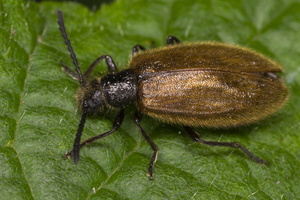- sort orderDefault
Photo title, A → Z
Photo title, Z → A
✔ Date created, new → old
Date created, old → new
Date posted, new → old
Date posted, old → new
Visits, high → low
Random
 home / Insecta · vabzdžiai / Coleoptera · vabalai / Tenebrionidae · juodvabaliai / Lagria hirta · paprastasis gauravabalis
home / Insecta · vabzdžiai / Coleoptera · vabalai / Tenebrionidae · juodvabaliai / Lagria hirta · paprastasis gauravabalis
creation date / 2007 / August / 4

- rough-haired Lagria beetle
- Håret skyggebille, Håret uldbille, Lådden femfemfire bille
- Gemeine Wollkäfer
- niittymartikas
- paprastasis gauravabalis
- pūkainā sarvabole
- Gewone ruigkever, Harige wolkever, Grote ruige kever
- omięk powolny
Most of the text below is from now defunct site www.ukbeetles.co.uk, where it was published under a CC BY 4.0 License.
Lagria hirta is a very widespread species occurring throughout Europe including Scandinavia, North Africa, and The Middle East and across Russia to East Siberia. In the U.K. it is generally common throughout England and Wales north to South Yorkshire, further north there are scattered records to northeast Scotland. Adults occur from May to late July and may be found in a wide range of habitats including open woodland, grassland and urban gardens etc., they may be very common in areas with light or sandy soils but they also occur in wet areas. They are crepuscular and nocturnal and fly readily, being often attracted to u.v. light, during the day they may be found resting on trunks or walls etc. or in various ‘open’ flowers e.g. daises, yarrow or umbels where they feed upon nectar or pollen. During hot weather they may be seen basking on nettle foliage etc. Eggs are laid in humous-rich soil and hatch after about 8 days. The larvae feed upon decaying vegetation among litter or turf and overwinter, pupating in the soil in the spring. Adults begin to emerge from the soil in May and quickly become common.
Lagria hirta can reach a length of 7–8 mm. These beetles have a soft and elongated body and a head and thorax brown or shiny black. The relatively elongated elytra are yellowish-brown and covered by dense fine light yellowish-brown hairs. The rest of the body is also hairy, but they are less clearly visible. Antennae, underside of body and legs are black. The eyes are remarkably large and round. Antennae are composed with eleven segments.
The elytra of the females are more extended backward than in the males and the female's abdomen looks from above wider than in the males. The male, in addition to its slimmer body, is distinguished from the females by their larger eyes and by the length of the last segment of the antennae, which is nearly twice the corresponding segment in the female. The hind wings are transparent.
Lagriinae, formerly Lagriidae, Cucujidae
